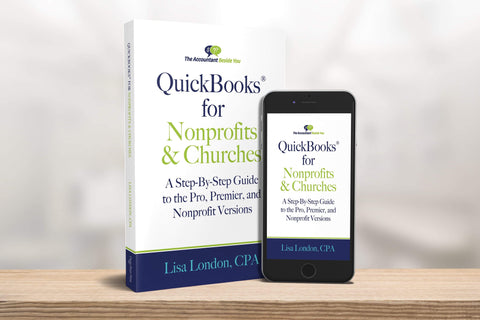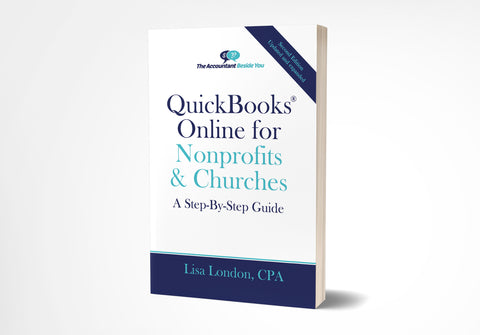Five Crucial Elements for a Strong Nonprofit Accounting System
With the start of a new year, many nonprofit organizations and churches are considering new accounting systems. If you are working with a nonprofit organization you feel passionate about, it is natural to focus on the mission and the programs. But equally important is the need to accurately track the financial tasks.
Here are the five crucial elements necessary to maintain a strong financial system to fund your nonprofit’s mission.
-
Internal accounting controls
Donors to an organization want to know systems are in place to keep the money and other assets safe and that they are being used as intended. No organization is too small to develop a system of internal controls. -
Bookkeeping system.
Whether this is done with a simple checkbook and spreadsheet or on a computerized accounting program, the system needs to be able to track money in and out by donor, program, and account category. Checking accounts should be easy to reconcile. Money owed by members or others must be tracked. Money owed to vendors and others must also be accounted for. -
Donor acknowledgements.
If the organization is a 501(c)( 3), there are specific rules the nonprofit organization must follow to acknowledge the donation in order for it to be tax deductible for the donor. If your organization does not follow these rules, your donors may lose their tax deduction. -
Management reporting.
The Board, executive director, and program directors need information from the financial system to oversee operations and plan programming. These needs must be understood and designed into the processes. -
External reporting.
Donors, grantors, lenders, auditors, and government agencies may require specialized reporting. Is your system designed to handle this?
First, we'll review the basics of internal accounting controls and bookkeeping systems. Then we will cover donor acknowledgements and the differences between management and external reporting.
#1 Internal Accounting Controls
Internal accounting controls are the procedures you set in place to safeguard against fraud, theft, and errors. If you are thinking, "We don't have to worry about that. No one in our organization would steal," search the Internet with the phrase "stealing from nonprofits."The stories of seemingly nice people who stole hundreds of thousands of dollars from nonprofits will shock you. By implementing a few basic controls, it is fairly easy to prevent fraud.
When designing your controls, remember this basic concept:
If someone has access to the money, they cannot have access to the accounting or donor records.
In a nutshell, this means that the person collecting the cash or signing the checks should not be the person recording the transactions in the accounting system. It also means the treasurer should not also be the bookkeeper.
I can hear you say, "But wait. That is what the treasurer does. Our organization is too small to have a bookkeeper separate from the treasurer. "If that is the case, you will simply need to rethink how you use your treasurer.
For example, if you have a small association or civic group with members who pay their dues at the meeting, have a second person sit next to the treasurer/bookkeeper as the money is being collected. At the end of the meeting, count up the checks and cash, record it on a piece of paper, and have both people sign it. This signed paper is later reconciled to the bank deposit to assure all the money received was deposited.
When paying bills, have the treasurer/bookkeeper write the checks, but the check signers would be the president, secretary, or board members and not the treasurer. The check signers must review the invoices before signing to assure themselves it is a legitimate expense of the organization. This allows the treasurer to record the transactions but not be able to withdraw the money.
# 2 Bookkeeping Systems
Nonprofit accounting is a bit different than for-profit accounting. Instead of profits and retained earnings, a nonprofit has net assets. Money or items donated for a specific purpose are tracked through restricted funds. So the bookkeeping system you select must be able to handle these types of transactions.
Bookkeeping systems can be very basic with simply a checkbook and a spreadsheet to track the types of income and expenses. Or they can be quite elaborate with nonprofit specific software which accounts for funds and restrictions on donations as well as donor management databases. Often nonprofits take an off-the-shelf accounting package geared towards for-profit businesses and try to make it work.
Which you decide to use depends on the organization's budget, needs, and expertise of the staff. If you are starting a small sports league with a dozen members and very little money, a spreadsheet will probably be sufficient.If you have several million dollars of grants with specific reporting requirements, you'll probably want to purchase a nonprofit-specific accounting program. Many nonprofits use QuickBooks® as it is easy to learn and, with some manipulation, can be utilized for the specifics of nonprofit accounting.
When selecting or upgrading your accounting system, you'll need to evaluate the following:
- How much can I spend? Is it better to spend more on the system if it will save time? Spreadsheets are cheap, but it takes time to set up the system and formulas and errors are more likely.Are you going to spend so much time working with it that your program work suffers?If so, you would be better off looking at a computerized accounting system. Check out www.techsoup.org for discounts and free software for nonprofit organizations. For example, a $300 QuickBooks package can be purchased by an eligible nonprofit for only $45.
- How many donors and transactions do I have? If the organization's money comes from thousands of donors, you'll want a system that can handle them. If you only have one or two sources of income, a simpler system will be adequate.
- Do I want it cloud based on or on a computer in an office? Cloud-based (Internet-based) accounting packages are very convenient, especially for organizations without a physical location. But they tend to cost a bit more as you pay for them monthly for as long as you use them instead of a one-time cost up front. Your internet reliability is a major factor. If you live in an area without consistent access, you will be very frustrated if you can't get into the system when you want. Additionally, the internal controls have to be taken into consideration. Does the package allow for users to access reports only? You may want the board members to see the data, but not to manipulate it.
- Is the system intuitive? If the organization changes treasurers and bookkeepers on a regular basis, the system has to be easy to learn. I wrote my first books, QuickBooks for Churches and Other Religious Organizations and Using QuickBooks for Nonprofit Organizations, Associations, & Clubs, after helping a church try to reconcile their accounts on a large expensive system that was difficult to use. I realized that churches (and other nonprofits) often have volunteers, and so switching to an accounting system many people are familiar with (like QuickBooks) makes training new treasurers and bookkeepers much easier. QuickBooks isn't designed for nonprofits, so you have to learn a few tricks to make it work, but it is a user-friendly program.
- Is it easy to perform the daily/monthly tasks? Entering donations, writing checks, and reconciling the bank account should be easy.
Once you have found a system in your price range that will easily keep your books, take the time to learn the system. Ask for advice from a CPA or members and supporters with accounting experience. If you set up your accounting system correctly from the beginning, it will run so much smoother, leaving you more time to focus on your nonprofit’s mission.
#3 Donor Acknowledgements
The third crucial element in my list is donor acknowledgements. The IRS requires the donor to keep a written record of any gift over $250 in order to maintain the deductibility.
From the IRS website:
A donor can deduct a charitable contribution of $250 or more only if the donor has a written acknowledgment from the charitable organization. The donor must get the acknowledgement by the earlier of:
1.The date the donor files the original return for the year the contribution is made, or
2.The due date, including extensions, for filing the return.
The donor is responsible for requesting and obtaining the written acknowledgement from the donee.
A donor cannot claim a deduction for any contribution of cash, a check or other monetary gift made on or after January 1, 2007, unless the donor maintains a written record of the contribution.
From Church Accounting: The How-To Guide to Small & Growing Churches, the written acknowledgment must contain the following information:
- Name of the organization
- Amount of cash contribution
- Description (but not value) of non-cash contribution
- Statement that no goods or services were provided by the organization, if that is the case
- Description and good faith estimate of the value of goods or services, if any, that the organization provided in return for the contribution.
An organization should have procedures in place to thank donors as soon as possible after receipt of the donation. Some accounting programs will allow you to email the donor directly from the donation receipt screen. There is a free video at my website, www.accountantbesideyou.com showing how to do this in a QuickBooks program.
|
|
Accounting packages frequently do not have strong donor management functions. You may want to investigate donor management programs that will interface with your accounting system. The interface is important as you do not want to have to enter data twice.
#4 Management Reporting
If you speak to an accountant, you may hear a strange language that references words like GAAP or FASB. These are not science fiction terms, but relate to the accounting rules financial reports need to follow if being reported to the public. The management of a nonprofit may need to look at things differently than these rules require. For example, one of the accounting rules requires pledges to be recorded as income when the pledge is received, not when the cash is received. If it is a multi-year pledge, this can make the financial statements look very good, but it does not show the management when to expect the cash.
A few of the reports the board, the executive director, development director, or the program directors may need include:
- Budget vs Actual Statement of Activities (income and expenses) for the organization
- Budget vs Actual Statement of Activities for each program/grant
- Donor/Grant report to summarize the related income and expenses for a grant
- Statement of Financial Position (Balance Sheet)
- Cash reports including restricted vs unrestricted cash and cash projections
- List of largest donors or grants
These reports provide the management an overall view of how the programs are raising and spending money related to expectations and donor wishes, if cash will be available for the expected expenses, and the overall financial health of the organization.
Most importantly, talk to the staff and board about what information they need to do their jobs well and design the reports around these needs. Ask if the reports should be on a cash basis (i.e. income and expenses are recorded only when received or paid) or on an accrual basis (recorded when pledge is received and when expenses are incurred regardless of when the cash is received or paid). How detailed should the expense line items be? How often should a new forecast be prepared? Is the system capable of doing the necessary reporting without having to use too many spreadsheets?
#5 Outside Reporting
Besides management, other groups may have reporting requirements for your organization. These are usually required to follow the stringent financial reporting rules. Reports are required for outside auditors or an audit committee, any lenders, foundations from which you have received or are requesting grants, etc.
Each group will have their own requirements, but the basic financial statements are:
- Statement of Activities (Income Statement) for the entire organization
- Statement of Financial Position (Balance Sheet)
- Statement of Cash Flows
- Statement of Functional Expenses (report showing expenses by major programs, administrative costs and fundraising costs). Required for larger organizations filing Form 990.
Make certain your accounting system can handle the required reports in an easily-accessible manner to keep your life easier.
An accounting system which addresses these five major areas -- internal controls, bookkeeping, donor acknowledgements, management reporting, and outside reporting -- will give you the tools you need to better focus on the mission of the organization.




